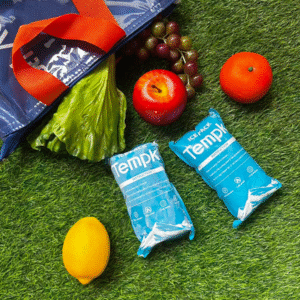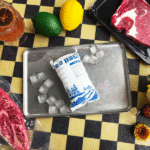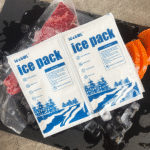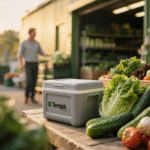What Makes Small Dry Ice Pack Sheets Essential for Cold Chain Logistics?
In today’s cold chain logistics, maintaining the correct temperature is crucial for shipping perishable and temperature-sensitive products. Small dry ice pack sheets are becoming indispensable in industries like pharmaceuticals, food, and biotechnology due to their superior temperature control and cost-efficiency. These sheets ensure your goods stay at the required temperature for longer periods, reducing spoilage and saving on shipping costs. In this guide, we’ll explore how these innovative sheets work, their benefits, and why they should be a part of your cold chain solution in 2025.
-
How do small dry ice pack sheets work in cold chain logistics?
-
What are the benefits of dry ice over traditional cooling methods?
-
How can you maximize the effectiveness of these sheets for temperature-sensitive shipments?
-
What trends are shaping the future of small dry ice pack sheets in cold chain logistics?
What Are Small Dry Ice Pack Sheets and How Do They Work?
Small dry ice pack sheets are flexible, compact sheets filled with dry ice pellets. Unlike traditional ice packs, dry ice sublimates directly from solid to gas, which means it absorbs heat from its surroundings without leaving any water residue. This makes it an ideal solution for industries that require precise temperature control during transportation, such as pharmaceuticals, food, and biotechnology.
The Science Behind Dry Ice Pack Sheets
These sheets are designed to maintain extremely low temperatures of up to -78.5°C (-109.3°F). The dry ice in the sheets absorbs heat and converts into gas, cooling the environment around it. The absence of liquid in the form of melting ice means that no moisture or water damage occurs, which is crucial for sensitive products like vaccines, biologics, and frozen food.
| Feature | Traditional Ice Pack | Small Dry Ice Pack Sheets |
|---|---|---|
| Temperature Range | 0-5°C (32-41°F) | -78.5°C (-109.3°F) |
| Cooling Duration | 6-24 hours | 24-48 hours |
| Water Residue | High (melts) | None (sublimates) |
| Cost-Effectiveness | Requires frequent replacement | Longer-lasting and cost-efficient |
Why Choose Small Dry Ice Pack Sheets Over Traditional Methods?
Small dry ice pack sheets are rapidly replacing traditional cooling methods like gel packs and liquid ice for several reasons:
-
Superior Temperature Consistency: Dry ice maintains a consistent ultra-low temperature without fluctuations, ensuring sensitive products like pharmaceuticals are kept within the required range throughout the journey.
-
No Water Damage: Traditional ice can melt and potentially cause water damage, which is a major risk for perishable goods. Dry ice sublimates directly into gas, leaving no moisture behind.
-
Space Efficiency: Dry ice pack sheets are compact and flexible, meaning you can store and transport more products in a given space compared to traditional ice packs that require larger containers for storage.
-
Eco-Friendly: Many dry ice sheets are reusable and can be refrozen, reducing waste compared to single-use gel packs and liquid ice.
Maximizing the Effectiveness of Small Dry Ice Pack Sheets
To make the most of small dry ice pack sheets, it’s essential to follow best practices for temperature-controlled logistics:
-
Proper Layering and Placement: Ensure that dry ice sheets are placed around products for even cooling. For products sensitive to extreme cold, use a barrier to avoid direct contact with the dry ice.
-
Use with Insulated Containers: Pairing dry ice with high-quality insulated packaging (e.g., Styrofoam or polyurethane) can extend the cooling duration by reducing the impact of external temperature changes.
-
Monitor Temperature Continuously: Using temperature sensors and real-time tracking devices helps ensure that the correct temperature is maintained throughout the shipment.
How Small Dry Ice Pack Sheets Compare to Gel Packs and Ice Packs
| Cooling Method | Small Dry Ice Pack Sheets | Gel Packs / Ice Packs |
|---|---|---|
| Temperature Range | -78.5°C (-109.3°F) | 0-5°C (32-41°F) |
| Cooling Duration | 24-48 hours | 6-12 hours |
| Reusability | Yes (if hydrated and stored correctly) | Yes (but shorter lifespan) |
| Ideal Use Cases | Pharmaceuticals, frozen foods, vaccines | Dairy, fresh produce |
When to Use Each Cooling Solution:
-
Small Dry Ice Pack Sheets: Ideal for shipments requiring sub-zero temperatures such as vaccines, biologics, and frozen meals.
-
Gel Packs: Best suited for chilled products like fresh produce and dairy, where maintaining a refrigerated temperature (2-7°C) is sufficient.
Industry Applications for Small Dry Ice Pack Sheets
1. Pharmaceutical Industry
In the pharmaceutical industry, temperature fluctuations can affect the efficacy and safety of drugs and vaccines. Small dry ice pack sheets are essential for maintaining the ultra-low temperatures required by these products, ensuring compliance with regulatory standards and reducing the risk of spoilage during transit.
2. Food and Beverage
For the food industry, particularly in shipping perishable items such as seafood, meat, and ice cream, maintaining consistent freezing temperatures is vital. Dry ice sheets keep food products frozen and preserve their texture, flavor, and safety during transportation.
3. Biotechnology
In biotechnology, products like biological samples, blood, and DNA require strict temperature control to maintain their integrity. Dry ice is often the preferred solution for transporting these sensitive materials, as it provides reliable cooling over long distances.
Trends Shaping the Future of Small Dry Ice Pack Sheets in 2025
Advancements in IoT Technology
Real-time temperature monitoring systems are becoming integral in cold chain logistics. These IoT-enabled devices allow businesses to monitor the temperature of their shipments continuously, ensuring that the small dry ice pack sheets maintain their cooling efficiency.
Sustainability in Cold Chain Logistics
As businesses prioritize sustainability, the use of reusable dry ice pack sheets and eco-friendly packaging solutions are becoming standard practice. Many dry ice producers are now using CO₂ captured from renewable sources, reducing the carbon footprint of cold chain logistics.
Smart Packaging
The integration of smart sensors into packaging is helping businesses improve temperature monitoring and enhance the overall efficiency of their cold chain logistics. These innovations ensure that the cooling process is optimized and that temperature deviations are quickly detected and addressed.
Frequently Asked Questions
How long do small dry ice pack sheets last during transit?
Small dry ice pack sheets can typically last between 18 to 48 hours, depending on the size of the shipment, the quality of insulation, and ambient temperatures.
Can small dry ice pack sheets be reused?
Yes, small dry ice sheets are reusable, but they must be properly hydrated and stored to ensure their longevity.
Conclusion and Recommendations
Small dry ice pack sheets are a game-changer in the cold chain logistics industry. With their superior temperature control, longer cooling durations, and eco-friendly benefits, they provide a reliable and cost-effective solution for shipping temperature-sensitive goods. To ensure the best results, businesses should combine dry ice with best practices such as proper insulation, temperature monitoring, and compliance with safety regulations.
Next Steps:
Start evaluating small dry ice pack sheets for your logistics operations. Consider the type of products, duration of shipment, and required temperatures to determine the best solution for your needs.
About Tempk
At Tempk, we specialize in providing innovative cold chain solutions tailored to the pharmaceutical, food, and biotechnology industries. Our products ensure temperature-sensitive goods are transported efficiently and sustainably, with a focus on reducing environmental impact.
Call to Action: Contact us today to discuss how our small dry ice pack sheets can optimize your cold chain operations.
























